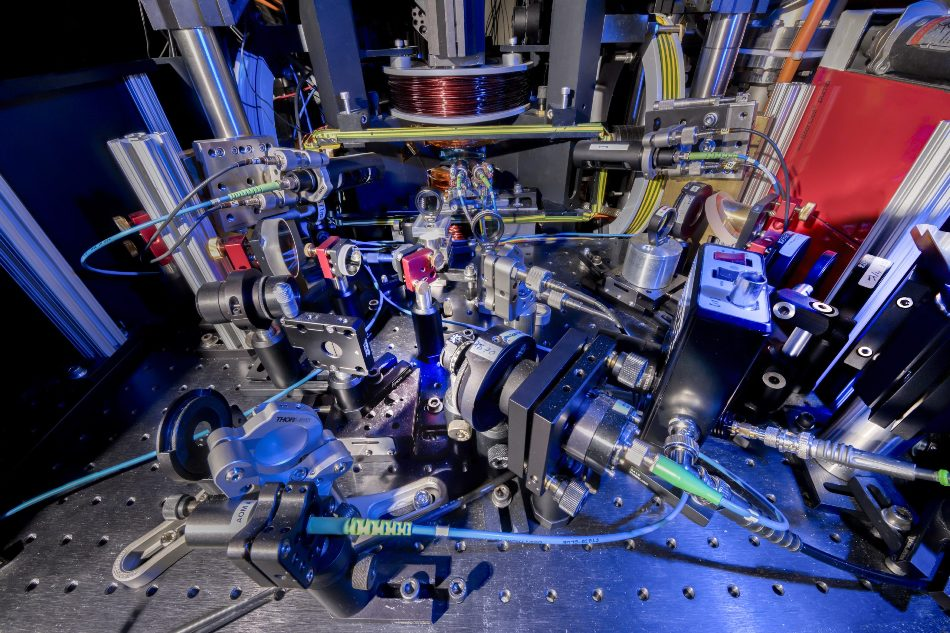A study performed by researchers at the Swinburne University of Technology has analyzed the propagation of energy as sound waves in a medium of quantum gas. For the first time, the powerful differences in the nature of the sound wave have been revealed as a function of temperature.
 Ultracold atomic lab at the Swinburne University of Technology. Image Credit: FLEET.
Ultracold atomic lab at the Swinburne University of Technology. Image Credit: FLEET.
The study was recently published in the Physical Review Letters journal in March 2020.
At minimal energies, this type of energy moves through the combined movement of several particles that are moving in a coordinated fashion—fundamentally, as sound waves –and measured using quasiparticles called phonons.
In a unitary Fermi gas, these sound waves can propagate without collisions below the superfluid transition temperature Tc. These sound waves are powered by ripples in the phase of the superfluid order parameter, also known as wave function—this mode is called the Bogoliubov-Anderson (BA) phonon. However, the sound waves turn out to be more powerfully damped above superfluid transition temperature Tc, with collisions playing a major role.
- <Tc—below the transition temperature: In the colder, superfluid mode, damping is governed by collisions with thermally stimulated quasiparticles and this has been clearly elucidated by (QRPA) theory.
- >Tc—above the transition temperature: The powerfully damped mode takes place at the crossover between collision-less hydrodynamic regimes.
- >>Tc—at even greater transition temperatures: The entire propagation of sound waves disappears, and excitation is governed by the energy of separate particles.
Intense similarities were detected in the behavior of phonons present in liquid helium and the temperature reliance of sound existing in the unitary Fermi gas. The former was one of the first superfluids to be detected historically. This work offers quantitative benchmarks for dynamical systems of powerfully correlated fermions.
More About the Study
The ultracold atomic gases, developed and examined in Professor Chris Vale’s laboratory at the Swinburne University of Technology, enable highly accurate tuning of atom-atom interactions.
We cooled and confined a highly dilute gas of Li6 atoms, realising a unitary Fermi gas, which exhibits the strongest interactions allowed by quantum mechanics with a contact potential.
Chris Vale, Professor, Swinburne University of Technology
Elastic collisions in a unitary gas become resonant and the gas’s thermodynamic properties become universal functions of the density and temperature. Accurate testing of theories of the interacting fermion is facilitated by unitary Fermi gases.
Using two-photon Bragg spectroscopy, the researchers subsequently analyzed excitations in the gas below and above the superfluid phase transition Tc.
We measured excitation spectra at a momentum of approximately half the Fermi momentum, both above and below the superfluid critical temperature Tc.
Dr Carlos Kuhn, Study Author, Swinburne University of Technology
A pair of focused laser pulses (about 1.2 ms in duration) crossing inside the gas produce a periodic perturbation for the lithium atoms. Soon after the twin focused laser pulse, the restraining optical trap is turned off and the atoms’ momentum is quantified following an expansion of 4 ms, and this can be plotted as a function of laser frequency.
The limited size and duration of the Bragg beams result in a Fourier-limited spectral resolution of about 1:25 kHz FWHM, which is much below the regular Fermi energies, EF 11 kHz, employed in the experiments.
The study is titled “High Frequency Sound in a Unitary Fermi Gas.”
In addition to support from the Australian Research Council, the study’s authors expressed their thanks to M. Zwierlein, Y. Castin, and H. Hu for motivating discussions and also to J. Denier for supporting the initial experiments. The authors also acknowledge financial support from the Independent Research Fund of Denmark.